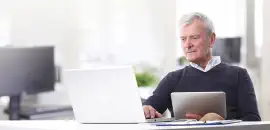

Key Takeaways
- The SECURE Act 2.0 became law in late 2022 after bipartisan support, expanding on earlier retirement reforms.
- The law introduces more than 90 provisions aimed at helping workers save, including automatic 401(k) enrollment for new plans.
- Catch-up contribution limits rise for older workers, and high earners will be required to make these extra contributions on an after-tax Roth basis.
- Employers can now match student loan payments and offer Roth employer matches, widening access and flexibility in workplace plans.
- The Act delays required minimum distributions, reduces penalties for missed withdrawals, and adds a national database to help people track down lost retirement accounts.
When Congress passed the Setting Every Community Up for Retirement Enhancement (SECURE) Act in late 2019, it was one of the largest reforms for retirement plans in years. Now, Congress has expanded on these reforms with the SECURE Act 2.0, which was signed into law at the end of 2022.1
Here's a look at the key provisions of the new law and what the new retirement plan rules could mean for you.
How the SECURE Act 2.0 Came to Be
In May 2021, the U.S. House of Representatives Ways and Means Committee passed a bill called the "Securing a Strong Retirement Act of 2021."2 They nicknamed it the "SECURE Act 2.0" because it followed up on many of the changes from the original SECURE Act, which offered tax credits to employers who proactively updated their operations to make it easier for employees to save for retirement.1
The rest of Congress was supposed to vote on the bill in 2021, but it stalled when the focus shifted to President Joe Biden's Build Back Better legislation. However, in December 2022, the bill successfully passed both the Senate and the House with bipartisan support and President Biden signed it into law.
Key SECURE Act 2.0 Changes
The SECURE Act 2.0 includes several changes that could make it easier for employers to sponsor and manage retirement plans and for Americans to save for the future. The law contains more than 90 new provisions, including new rules that affect automatic enrollment in retirement plans, 529 rollovers and even student loan debt repayments. Here are some of the larger changes:
Automatic 401(K) Enrollment
Before this law passed, employers offering 401(k)s and other defined-contribution plans could choose whether to automatically enroll new employees.
If employers chose not to:
- Employees had to opt in on their own.
- They also had to decide how much of their paycheck to contribute.
- Many never enrolled, which meant missing out on retirement savings and any employer matching contributions.
The SECURE Act 2.0 now makes automatic enrollment mandatory for any new 401(k) or defined contribution plan.3
| Feature | Requirement |
|---|---|
| Automatic Enrollment |
Required for new plans |
| Starting Contribution Rate |
At least 3% of the employee’s paycheck |
| Annual Increase |
+1% each year |
| Target Range |
Minimum 10% and up to 15% (employer decides the upper level) |
With the new retirement plan rules, you can adjust your retirement withholding or opt out altogether, but you need to proactively make these changes.
Increased 401(K) & IRA Catch-up Contributions
While workers younger than 50 years old are held to retirement contribution limits, older workers can contribute more per year through catch-up contributions.
Maximum 401(k) Contribution
If you're between ages 62 and 64, the SECURE Act 2.0 allows you to put aside an extra $10,000 a year for your catch-up contributions. This amount will increase based on inflation.
The new law also moderately boosts catch-up contributions for individual retirement accounts (IRAs).
| Before SECURE Act 2.0 | Under SECURE Act 2.0 (Started in 2024) |
|---|---|
| People age 50+ could add an extra $1,000 per year to an IRA. |
The $1,000 limit did not increase with inflation. |
| The $1,000 limit did not increase with inflation. |
Adjustments will follow the federal government's cost-of-living increases.5 |
What this means: If you're 50 or older, these inflation-based adjustments can help you save more each year if you choose.
Required After-Tax Catch-up Contributions for High Earners
When you make a catch-up contribution to your retirement plans, you have two options:
1. Pretax Contributions
- Applies to: Traditional IRA or 401(k)
- Tax treatment: You delay paying income tax on the money until you withdraw it in retirement.
2. After-Tax Contributions
- Applies to: Roth IRA or Roth 401(k)
- Tax treatment: You pay income tax on the money now instead of when you withdraw it in retirement.
The SECURE Act 2.0 has changed the law around catch-up contributions for high-wage earners. Beginning in the 2025 tax year, if you make more than $150,000 in the prior calendar year, you can make catch-up contributions only into a Roth account.5 The wage threshold adjusts for inflation every year.5 This specific provision means you have to pay taxes on catch-up contributions sooner, rather than deferring them until retirement. This rule is designed to help the government offset the costs of other parts of the bill.
Option To Receive After-Tax Matching Contributions
Traditionally, employer matching contributions in a 401(k) were treated as pretax contributions. Under the SECURE Act 2.0, you now have the option to receive some or all of your employer match as an after-tax (Roth) contribution.5 Here’s how that affects you:
- Pretax match: Taxes are deferred until you withdraw the money in retirement.
- Roth match: You pay income tax upfront, so qualified withdrawals in retirement - including any investment gains - are tax-free.
Choosing a Roth match means you've already paid income tax on that portion of your retirement savings before you withdraw it later in life.
More Access to Workplace Plans for Part-Time Employees
The original SECURE Act made it easier for part-time workers to join their workplace retirement plans. Before the passage of this law, you could only enroll in a 401(k) if you had worked for the company at least 1,000 hours in a year (about 20 hours a week).
The original SECURE Act changed it so that you could join an employer's retirement plan if you had worked at least 500 hours a year (about 10 hours a week) for three years. The SECURE Act 2.0 now allows you to be eligible starting in 2023 and shortens the required working time to two years.6
Matching Contributions for Student Loan Payments
If you're paying off student loans, saving for retirement may be challenging. This may mean you also miss out on employer matching contributions.
The new law allows employers to offer retirement plan matching contributions based on student loan payments.7 For example, say you pay $5,000 a year toward student loans. Your employer could calculate a 401(k) match as if you had put that $5,000 into your 401(k).
While the IRS has issued rulings suggesting this is already OK, employers had been hesitant to do it because Congress hadn't passed a formal law. The SECURE Act 2.0 now makes it legal and clear that employers can make matching contributions for student loan payments.
Later Ages for Mandatory Retirement Distributions
Pretax retirement plans like traditional 401(k)s and IRAs defer taxes on income. However, the government eventually needs to collect these taxes. That's why it has set an age limit when you must start taking required minimum distributions (RMDs). At that age and after, if you don't withdraw enough money from your retirement in a year, the IRS charges a tax penalty.
The original SECURE Act changed the age that RMDs must start from 70½ to 72 to give people more time to grow their savings. The SECURE Act 2.0 pushes RMDs out even later. It first increases the age limit to 73 in 2023 and then to 75 in 2033 to keep up with increasing life expectancies.8
Reduced Penalties for Missed RMDs
Before the SECURE Act 2.0, the penalty for missed RMDs amounted to 50% of what you should have withdrawn. For example, if you missed taking an RMD of $10,000, you would owe a tax penalty of $5,000.
The new law reduces this penalty to 25%. It also allows you to fix any mistakes by withdrawing the appropriate amount and then paying a penalty of just 10%.5
Database for Lost Retirement Plans
While it might seem strange to lose track of retirement savings, it happens frequently. Roughly 24 million 401(k)s are lost with over $1.3 trillion in savings.9 This sometimes happens because an employee left their job, didn't take their retirement savings with them and then forgot about it. An old account can be even harder to find if a past employer has gone out of business.
State governments have missing money and property departments for these accounts, but they aren't coordinated across the country. This makes tracking down retirement plans complicated. However, the SECURE Act 2.0 will establish a national online searchable database of lost plans, known as "The Retirement Savings Lost and Found," that the Department of Labor will manage.10
Penalty-Free Rollovers for Certain 529 Plans
529 plans are intended to help families save for education, including private school and college. You can make after-tax contributions, and these contributions can grow tax-deferred. You then can withdraw your contributions and any investment gains, and you may not owe taxes if you use them to pay for qualified education expenses.
Maximum Rollover Contribution
The SECURE Act 2.0 now gives you more flexibility with 529 plans. Just keep in mind that any amount you roll over counts toward the beneficiary's annual Roth contribution limit.
Other Important Changes To Understand
Some other changes in the SECURE Act 2.0 include:
- Letting workplace retirement plans offer lifetime income annuities as investments (turning your savings into income for life, like a personal pension).
- Creating rules to make it easier to correct mistakes from using retirement plans without penalties, such as the mishandling of a 401(k) loan.
- Giving 403(b)s more design features like those currently available with 401(k)s.
- Requiring the Treasury secretary to better promote the Retirement Savings Contributions Saver's Credit, which helps low- and moderate-income taxpayers save for retirement.
Reviewing Your Retirement Plan in Light of Changes
The SECURE Act 2.0 dramatically overhauls America's retirement system. It creates new benefits and options for retirement savers. If you already have a retirement plan, you might want to consider making changes based on some of the new rules, like increasing your catch-up contributions or using after-tax matching contributions from your employer rather than pretax ones.
Final Thoughts
Because of all the new provisions, it may be worth meeting with a financial professional to review your individual situation. Together, you can start planning what adjustments you might want to make. As part of this discussion, you can also make sure you're up to date on all the changes from the original SECURE Act. Taking these proactive steps now could pave the way to a better retirement and financial future.
Prepare for retirement with the new provisions in the SECURE Act 2.0. Start Your Free Plan
Sources
- H.R.2954 - Securing a Strong Retirement Act of 2021. https://www.congress.gov/bill/117th-congress/house-bill/2954/text.
- A stalled retirement bill could be passed in 2022. https://www.barrons.com/articles/securing-strong-retirement-act-means-for-you-51640890247.
- ‘Secure 2.0’ clears Congress as part of omnibus appropriations bill, will bring more changes to U.S. retirement system. https://www.cnbc.com/2022/12/23/secure-2point0-clears-congress-will-bring-changes-to-retirement-system.html.
- 401(k) limit increases to $24,500 for 2026, IRA limit increases to $7,500. https://www.irs.gov/newsroom/401k-limit-increases-to-24500-for-2026-ira-limit-increases-to-7500.
- Catch-Up Contributions to Retirement Accounts Boosted By SECURE Act 2.0. https://www.kiplinger.com/retirement/catch-up-contributions-improved.
- H.R.2954 - Securing a Strong Retirement Act of 2021. https://www.congress.gov/bill/117th-congress/house-bill/2954/text#toc-H81C152232BBA401F815C6DA5D49925DF.
- H.R.2954 - Securing a Strong Retirement Act of 2021. https://www.congress.gov/bill/117th-congress/house-bill/2954/text#H48D1923AD8374C328D2DA4D3C2A9B1E4.
- H.R.2954 - Securing a Strong Retirement Act of 2021. https://www.congress.gov/bill/117th-congress/house-bill/2954/text#toc-HB9B18B5F05D04C1F8F7B67AC535C6314.
- The True Cost of Forgotten 401(k) Accounts. https://www.hicapitalize.com/resources/the-true-cost-of-forgotten-401ks/.
- H.R.2954 - Securing a Strong Retirement Act of 2021. https://www.congress.gov/bill/117th-congress/house-bill/2954/text#H80D91AD7D2D1472BB6EADD93CD20FB75.
- How unused 529 assets can help with retirement planning. https://www.fidelity.com/learning-center/personal-finance/529-rollover-to-roth.





























